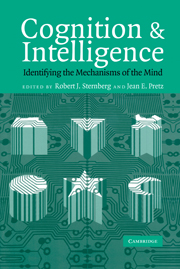Book contents
- Frontmatter
- Contents
- Preface
- 1 Information Processing and Intelligence: Where We Are and Where We Are Going
- 2 Mental Chronometry and the Unification of Differential Psychology
- 3 Reductionism versus Charting: Ways of Examining the Role of Lower-Order Cognitive Processes in Intelligence
- 4 Basic Information Processing and the Psychophysiology of Intelligence
- 5 The Neural Bases of Intelligence: A Perspective Based on Functional Neuroimaging
- 6 The Role of Working Memory in Higher-Level Cognition: Domain-Specific versus Domain-General Perspectives
- 7 Higher-Order Cognition and Intelligence
- 8 Ability Determinants of Individual Differences in Skilled Performance
- 9 Complex Problem Solving and Intelligence: Empirical Relation and Causal Direction
- 10 Intelligence as Smart Heuristics
- 11 The Role of Transferable Knowledge in Intelligence
- 12 Reasoning Abilities
- 13 Measuring Human Intelligence with Artificial Intelligence: Adaptive Item Generation
- 14 Marrying Intelligence and Cognition: A Developmental View
- 15 From Description to Explanation in Cognitive Aging
- 16 Unifying the Field: Cognition and Intelligence
- Author Index
- Subject Index
- References
13 - Measuring Human Intelligence with Artificial Intelligence: Adaptive Item Generation
Published online by Cambridge University Press: 23 November 2009
- Frontmatter
- Contents
- Preface
- 1 Information Processing and Intelligence: Where We Are and Where We Are Going
- 2 Mental Chronometry and the Unification of Differential Psychology
- 3 Reductionism versus Charting: Ways of Examining the Role of Lower-Order Cognitive Processes in Intelligence
- 4 Basic Information Processing and the Psychophysiology of Intelligence
- 5 The Neural Bases of Intelligence: A Perspective Based on Functional Neuroimaging
- 6 The Role of Working Memory in Higher-Level Cognition: Domain-Specific versus Domain-General Perspectives
- 7 Higher-Order Cognition and Intelligence
- 8 Ability Determinants of Individual Differences in Skilled Performance
- 9 Complex Problem Solving and Intelligence: Empirical Relation and Causal Direction
- 10 Intelligence as Smart Heuristics
- 11 The Role of Transferable Knowledge in Intelligence
- 12 Reasoning Abilities
- 13 Measuring Human Intelligence with Artificial Intelligence: Adaptive Item Generation
- 14 Marrying Intelligence and Cognition: A Developmental View
- 15 From Description to Explanation in Cognitive Aging
- 16 Unifying the Field: Cognition and Intelligence
- Author Index
- Subject Index
- References
Summary
INTRODUCTION
Adaptive item generation may be the next innovation in intelligence testing. In adaptive item generation, the optimally informative item is developed anew for the examinee during the test. Reminiscent of computer versus person chess games, the computer generates the next item based on the previous pattern of the examinee's responses. Adaptive item generation requires the merger of two lines of research, psychometric methods for adaptive testing and a cognitive analysis of items.
Adaptive testing is the current state of the art in intelligence measurement. In adaptive testing, items are selected individually for optimal information about an examinee's ability during testing. The items are selected interactively by a computer algorithm using calibrated psychometric properties. Generally, harder items are selected if the examinee solves items, while easier ones are selected if the examinee does not solve items. Adaptive item selection leads to shorter and more reliable tests. In a sense, optimal item selection for an examinee is measurement by artificial intelligence.
Adaptive item generation is a step beyond adaptive testing. Like adaptive testing, it estimates the psychometric properties of the optimally informative items for the person. Beyond this, however, the impact of specific stimulus content on an item's psychometric properties must be known. That is, knowledge is required of how stimulus features in specific items impact the ability construct.
This paper describes a system for measuring ability in which new items are created while the person takes the test. Ability is measured online by a system of artificial intelligence.
- Type
- Chapter
- Information
- Cognition and IntelligenceIdentifying the Mechanisms of the Mind, pp. 251 - 267Publisher: Cambridge University PressPrint publication year: 2004
References
- 2
- Cited by

